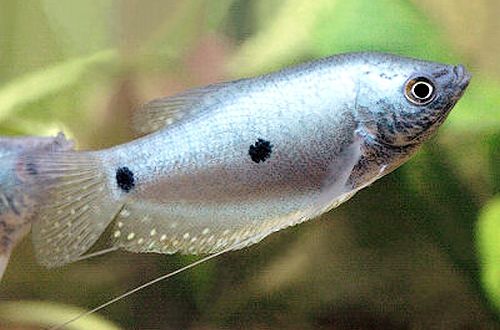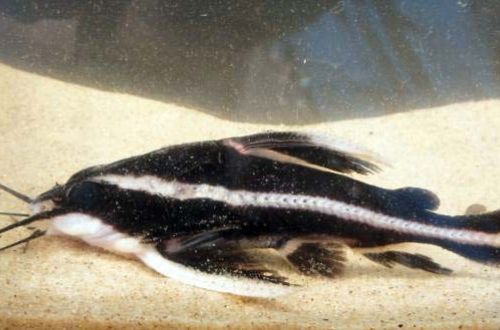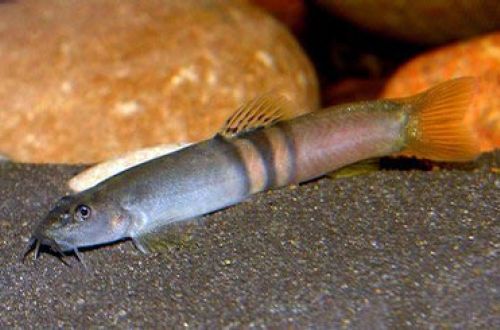
Blue Gourami
The Blue Gourami, scientific name Trichopodus trichopterus, belongs to the Osphronemidae family. This species has many color variations, most of which are artificially bred, but this particular variety is a direct descendant of its wild relatives. It is quite possible to catch the Blue Gourami in any reservoir in Southeast Asia, and the locals even use it as a game fish.

The fish has one important and useful feature – Gourami are happy to eat hydras, a great addition to his diet. The hydra is a tiny multicellular pest that occasionally inhabits the aquarium and causes a lot of problems. It is especially dangerous for small fish or fry, because it has stinging cells that paralyze the victim with poison.
In all respects, the Blue Gourami is a beautiful and hardy species, an excellent candidate for the first aquarium fish.
Contents
Habitat
Blue Gourami is widely distributed in the continental part of Southeast Asia and Indonesia in the territory of such modern countries as China, Vietnam, Laos, Cambodia, Thailand, Myanmar and Malaysia. Currently found far outside its natural range: Philippines, Taiwan, Papua New Guinea, Reunion Islands, Seychelles, Namibia, Dominican Republic, Puerto Rico and Colombia, etc. Apparently aquarium fish at one time release them into local reservoirs, where they have successfully settled in, so now Gourami lives on almost all continents.
In nature, these fish are found in flat wetlands, small streams and canals. They inhabit shallow waters with a slow current and dense vegetation. During the rainy seasons they migrate to flooded forests and fields. They feed on crustaceans, insect larvae and zooplankton.
Description
The elongated body is somewhat laterally compressed. Abdominal panics are filamentous and equipped with sensitive sensory cells, thanks to these “antennae” the fish explores the world around them by touching objects. The color is bluish, whitish-blue with irregular dark pigmentation, barely noticeable stripes. A distinctive feature is the presence of two spots, the first approximately in the middle of the body, the other at the base of the tail.
In nature, there is another color stamp – Brown Gourami, these are identical species, with the exception of color, as a rule, they live in different water bodies in nature.
Food
Since the vast majority of fish on sale have been living in the artificial environment of the aquarium for many decades, the diet has also undergone certain changes. In addition to live feed, it accepts all types of dry industrial feed, in addition, specialized feed is produced that takes into account all the needs for vitamins and microelements.
They will not refuse such a parasitic creature in the aquarium as hydra, in just a couple of days the Blue Gourami will relieve the aquarium of this problem. The nutritional features do not end there, in the hunt for prey (flies, small moths, etc.), the fish can release a stream of water, knocking down insects and subsequently collecting them from the surface of the water.
Maintenance and care
A spacious aquarium with a tight lid is required, under which a layer of air with high humidity and a temperature above room temperature is formed, this minimizes possible problems with the labyrinth organ of fish, with which they swallow atmospheric air. The set of necessary equipment is as follows: lighting system, aerator, heater, productive filter. When placing the filtration system, keep in mind that fish do not like water movement, so the filter exhaust manifolds should be pointed at the windows to break the stream. Ensuring high quality of water contributes to its weekly renewal of a quarter of the volume.
The design welcomes a large number of plants, both root and floating, arranged in groups. The presence of shelters is mandatory, they can be made in the form of grottoes, snags, sunken ships, castles, etc. The soil is of any texture, preferably dark, this will enhance the color of the fish.
Social behavior
Young individuals get along well with other peaceful and calm species, however, in adulthood, the Blue Gourami begins to show individual character traits, and rather polar ones, it can become both aggressive and intolerant of neighbors, and extremely friendly, so you should be ready to adapt aquarium community under the changed realities.
It should not be kept with small fish that can become easy prey, and problems arise with some species that are prone to biting off the fins of other fish, for example, these are all types of Barbs. There is fierce intraspecific competition, keeping several Gourami is only acceptable in a large aquarium with enough shelters. As
Sexual differences
Males are larger and have a long pointed dorsal fin, females are shorter and more rounded.
Breeding / breeding
Like most Gourami, the male creates a nest on the surface of the water from small sticky air bubbles where the eggs are deposited. For successful breeding, a separate spawning tank with a volume of about 80 liters or a little less should be prepared. Fill with water from the main aquarium to 13-15 cm high. The water parameters must match those of the main aquarium. Standard equipment: lighting system, aerator, heater, filter, giving a weak current of water. In the design, it is recommended to use floating plants with small leaves, for example, richia, they will become part of the nest.
The incentive for spawning is the inclusion of meat products (live or frozen) in the daily diet. After some time, when the female is noticeably rounded, the couple is placed in a separate tank, where the male starts building the nest. Upon completion of construction, the male begins courtship – swims back and forth near the female, tail raised above his head, touches with his fins. The female lays up to 800 eggs in the nest, after which she moves back to the main aquarium, the male remains to protect the clutch, he joins the female only after the fry appear.
Diseases
The Blue Gourami is close to wild relatives living in nature, therefore it has good immunity and health problems do not arise in a balanced aquarium. Read more about symptoms and treatments in the Aquarium Fish Diseases section.





